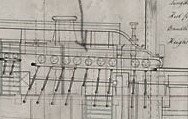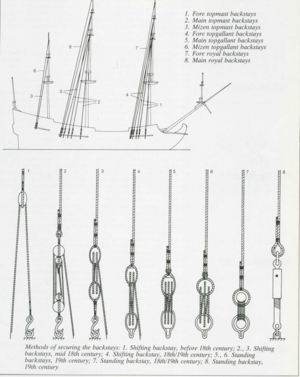You are using an out of date browser. It may not display this or other websites correctly.
You should upgrade or use an alternative browser.
You should upgrade or use an alternative browser.
Sorry not really answering your question but sometimes there are deadeyes on the channels that are not part of the shrouds/ratline rigging, Is this what you mean?
Last edited:
Could be, all the drawing shows is that one is smaller. What would they be for if not shrouds?
backstay. let me see if i can find the drawings for one of my old ships. I think that it shows this.Could be, all the drawing shows is that one is smaller. What would they be for if not shrouds?
Last edited:
I've got that book. I never think to look in it. But even if I did this topic is in the index under backstays and I didn't know I was looking for backstays. I looked every where I could for "small deadeyes" and found nothing. Sometimes even if you have the info it doesn't help when you are looking for it under a different name or such.
Anyway thank you very much Jack. Appreciate it.
Anyway thank you very much Jack. Appreciate it.
it's a good book but apparently full of mistakes according to some.
The diameter of the deadeyes is related to the diameter of the rope size caused by different forces.
On the main mast the ropes / backstays / shrouds have to take over higher forces than on the other smaller masts - therefore the ropes are thicker and therefore the deadeyes have to be bigger.
On the main mast the ropes / backstays / shrouds have to take over higher forces than on the other smaller masts - therefore the ropes are thicker and therefore the deadeyes have to be bigger.
Last edited:
Thanks Uwe, I may not have explained myself well. I was asking about the difference in size on the same mast. If you look at this picture the arrow is pointing at a deadeye that is smaller than the rest. I was wondering what that deadeye was used for. Sorry it's so small, I can't figure out how to enlarge it


- Joined
- Feb 20, 2022
- Messages
- 194
- Points
- 88

I believe Jack Sparrow is correct. To my understanding, these were one of the first examples of backstays used on ships. As masts got taller & sail area increased, more stays were "anchored" on the channels! See the book, The Rigging of Ships by R.C. Anderson, for one! This book has been invaluable to me for rigging my models! rick1011
Simply put…a smaller deadeye on the channel is normally the anchor point for a stay line not part of the main shrouds. The main shrouds take on most of the stress of the masts and would carry the ratlines. So smaller deadeyes are common and are the anchor points for the stays while the larger deadeyes are the anchor points for the shrouds.
Stays support a mast and lead from the head of one mast down to some other mast or other part of the vessel such as the chain plate channels; also any rigging running fore (forestay) and aft (backstab) from a mast to the hull. The stays support a mast's weight forward and aft, while the shrouds support its weight from side to side. Thus both shrouds and stays can be anchored to the chain plate channels.
Edit: Lower Shrouds normally originate from the lower mast head while stays can originate from several locations. Stays do not often align with shrouds. In addition, stays can anchor to other places on the ship such as pin rails inboard on the bulwarks and still use deadeyes or rigging blocks.
Edit2: In my experience I finish the shrouds and the ratlines before I rig the stays. I have discovered that often stays get in the way when trying to tie ratlines. On one model I was building I ran a stay down the middle of the shrouds as it was designed before I started tying ratlines. The stay was so much in the way that in frustration I cut the stay away…finished the ratlines…then rerigged the stay.
Stays support a mast and lead from the head of one mast down to some other mast or other part of the vessel such as the chain plate channels; also any rigging running fore (forestay) and aft (backstab) from a mast to the hull. The stays support a mast's weight forward and aft, while the shrouds support its weight from side to side. Thus both shrouds and stays can be anchored to the chain plate channels.
Edit: Lower Shrouds normally originate from the lower mast head while stays can originate from several locations. Stays do not often align with shrouds. In addition, stays can anchor to other places on the ship such as pin rails inboard on the bulwarks and still use deadeyes or rigging blocks.
Edit2: In my experience I finish the shrouds and the ratlines before I rig the stays. I have discovered that often stays get in the way when trying to tie ratlines. On one model I was building I ran a stay down the middle of the shrouds as it was designed before I started tying ratlines. The stay was so much in the way that in frustration I cut the stay away…finished the ratlines…then rerigged the stay.
Last edited:
Thanks Daniel
I think Steel answers this.
Here is what he says about topmast back stays.
One end is made fast to the chain-plates, abreast the mast, with a half-hitch, and the end seized down. In the other end is spliced a double block, connected by its fall to a double block that is strapped with an eye, through which a span is reeved, that has an eye spliced in each end, by which it is lashed to the chain-plates.
Here is part of my Investigator STD rigging plan.
Steel calls for 2 backstays (for a vessel like Investigator) and I showed them going to the after end of the channel.
However reading his description, it sounds like 1 could be a stay to the middle of the channel and 1 to the after part.
Most references show both to the aft part of the channel.
On a larger vessel 1 backstay and 2 after backstays. This is confirmed by the drawing in his book.
Regards
Allan
Here is what he says about topmast back stays.
THE BREAST BACK-STAY
has a single block turned into the lower end, with a throat and round seizing, through which the runner is reeved.One end is made fast to the chain-plates, abreast the mast, with a half-hitch, and the end seized down. In the other end is spliced a double block, connected by its fall to a double block that is strapped with an eye, through which a span is reeved, that has an eye spliced in each end, by which it is lashed to the chain-plates.
AFTER-BACK-STAYS
are set up, the same as a shroud, to a small dead-eye in the after end of the channel.SHIFTING-BACK-STAYS
are clenched round the topmast-head, and a thimble spliced in the lower end, to which is hooked a tackle, the lower block of which is hooked to an eye-bolt without-board, and frequently shifted from place to place.BACK-STAYS
are extended to the channels on each side, and are to support the topmasts, and assist the shrouds, when the mast is strained by a weight of sail.Here is part of my Investigator STD rigging plan.
Steel calls for 2 backstays (for a vessel like Investigator) and I showed them going to the after end of the channel.
However reading his description, it sounds like 1 could be a stay to the middle of the channel and 1 to the after part.
Most references show both to the aft part of the channel.
On a larger vessel 1 backstay and 2 after backstays. This is confirmed by the drawing in his book.
Regards
Allan
Attachments
Thanks Allan.




